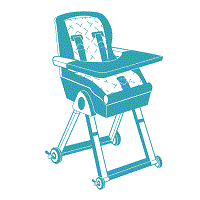Once your baby is ready for solid food, a highchair comes in very handy. It gives your child a safe place to experiment with new tastes and textures, and makes it easy for you to supervise meals – and clean up afterward.

Highchairs come in a wide variety of styles and prices. Choose one that's sturdy and easy to clean – it needs to be durable enough to withstand several years of daily use and abuse. Your child may use a highchair until age 2 or 3.
Basic highchairs with few flourishes will do the job, but the more expensive varieties may pay off over time. Some high-end models do a better job of growing with your child and holding up to wear and tear.
Types of highchairs
Basic metal- or plastic-frame highchairs
These models are fairly simple. Some are just molded plastic with seatbelts attached. Others have a bit of padding on the seat. Some have trays, others don't. Pros of these highchairs: They're usually inexpensive and lightweight. Some fold, so they're easy to move and store. Cons: They offer less comfort for your baby and less protection from the mess she'll inevitably make while eating.
Full-featured highchairs
These highchairs have all the features of basic models but also offer extras like well-padded seats, wheels to roll the highchair from one place to another, detachable trays that go on and off easily, dishwasher-safe tray covers, and adjustable height and seat recline. Some models convert into a booster seat or kid-sized chair to use when your child is older.
Portable and hook-on highchairs
Instead of a freestanding highchair, some families choose a seat that attaches to the table. These hook-on chairs can free up space in tight quarters, are transportable, and can cost less than standard highchairs. There are also portable highchairs that attach to a regular chair's seat and back with straps.
Wooden highchairs
Wooden highchairs can be very appealing, but they also have some important drawbacks. Often the seat is too deep and the footrest too low for an infant. And wooden trays are heavier and harder to clean than plastic, though they may have fewer of the tiny crevices that can trap crumbs and spills.
What to look for when buying
Type: Depending on your taste and needs, you may want a basic highchair, a high-end model with sleek styling, a full-featured highchair with lots of bells and whistles, or a smaller portable highchair or hook-on seat that attaches to the table. Pay attention to size and your space constraints.
Tray: Some highchairs don't have trays – you just push them up to the table. Others have trays that don't come off. The most convenient option, however, is a highchair with a tray that detaches easily and fits in the sink or dishwasher for cleaning. (Some trays have a dishwasher-safe cover.)
Ease of cleaning: Your child's food will find its way into every crack and crevice. Check the seat, harness, tray, and frame for tiny, hard-to-wipe areas – if you find a bunch, consider a different highchair. The seat and harness should be simple to wipe clean or remove and throw in the washing machine.
Versatility: Some highchairs convert into a booster seat or kid-sized chair to use when your child is older – up to age 5.
Adjustability: Chair height adjustment is handy, as is an adjustable tray to make sure your child's belly isn't constrained as he grows. Each adjustment should lock securely into place.
Sturdiness: Look for stability. Wide-based chairs are harder to tip over.
Comfort: Padded seats are easier on your baby's tush, and a footrest is a nice feature for older babies. Make sure any seams along the front of the seat have no sharp edges and won't scratch the back of your child's legs. Check the bottom of the tray for holes or sharp edges that could hurt your child's fingers.
Safety standards: Look for the Juvenile Products Manufacturers Association (JPMA) seal of approval on the highchair or packaging.
Safety harness: Your highchair should have a five-point safety harness, or a three-point harness and crotch post, to keep your child from standing up or slipping out. The buckle on the harness should be absolutely foolproof. A buckle that's too shallow or simple to operate can easily be undone, even by the pressure of your child's tummy. Harness straps should adjust to accommodate your growing child.
Wheels: These make it easy to move a highchair from room to room, say from the kitchen to the dining room. But make sure the wheels lock to prevent accidental rollaways.
Important safety notes
Children can be badly injured by falling out of a highchair, so always supervise your child in the highchair and keep the safety harness buckled. Follow the manufacturer's recommended weight and age limits if given.
More than 2 million highchairs have been recalled in recent years for a variety of safety problems, including pegs that stuck out and caused lacerations, safety belts that came unbuckled, and parts that broke or failed and allowed children to fall out of the chair.
Before buying a highchair or using a secondhand one, check our Product Recall Finder and latest recalls page to make sure the chair hasn't been recalled.
Finally, vintage wooden highchairs are best used for decorative purposes only. Safety standards have changed over the years, and though pretty, your heirloom chair may not be safe for your child.
What it's going to cost you
A hook-on chair or portable highchair costs about $20 to $50. Standard highchairs start at around $20 and run to about $100, and top-of-the-line models can reach $500 or more.





